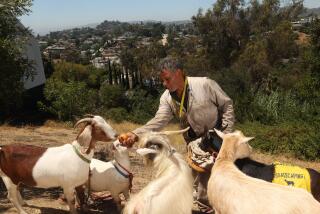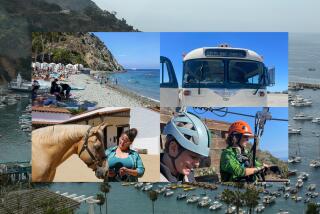Catalina Goats Being Shot to Protect Islandâs Ecosystem
Thousands of goats, descended from a handful brought to Santa Catalina Island by Spanish missionaries in the 1800s, are being eradicated by sharpshooting hunters hired to kill the beasts to protect the ecology on the west end of the island.
A team of biologists, armed with high-powered rifles and radios and tracking their prey from helicopters, is charged with eliminating as many as 3,000 of the wild goats.
Officials for the Santa Catalina Island Conservancy, which owns 86% of the land on the island, say the mass shootings are the only practical way to stop the animals from stripping the land of vegetation and threatening native species like the Catalina mahogany tree and the island fox.
About 1,700 goats have been killed since Jan. 15, and at least 1,000 more are being tracked by four high-tech hunters in the rugged island canyons farthest from the town of Avalon, said biologist David Garcelon, who is leading the hunt.
âThe goats are not part of the ecosystem on Catalina,â said Penelope OâMalley, a spokeswoman for the conservancy, which works to preserve many of the islandâs native plants and animals. âUnfortunately, we have to undo what was done in error before.â
But animal rights activists, who learned of the shootings Thursday, said they are outraged by what they called the âslaughterâ and might seek a court order to stop it.
âA mass execution, a mass hunt, falls into the category of cruel treatment,â said Dana Cole, a spokesman for the Fund for Animals. âThere are a wide variety of ways to trap animals. . . . We are always willing to come up with an alternative.â
In the mid-1980s, Fund for Animals volunteers stopped a plan by the Navy to shoot goats on San Clemente Island that was also meant to protect the natural island habitat. The organization was eventually given permission by the Pentagon to trap about 3,300 of the animals and take them to ranches in California and Texas.
Catalina conservancy officials said they considered trapping their goats, but discarded the idea as too difficult because of the rough terrain on the west end of the island. Besides, they concluded, many of the animals would just end up dying of shock in captivity--a theory that Cole said has been disproved.
The marriage between Santa Catalina Island, 22 miles off the coast, and domesticated goats may have been star-crossed from the start. Spanish missionaries are believed to have brought the goats to the island as food for the native Gabrielino Indians in 1827, even though the tribe had survived well on native plants, animals and fish, OâMalley said.
The Gabrielinos eventually relocated to the mainland, but the goats stayed and prospered, eventually growing to as many as 25,000 in the 1950s, said Doug Propst, president of the conservancy and a 37-year island resident.
The goats eat just about anything in their path, from grass and flowers to cactus and tree bark, Propst said. Over the years they have denuded vast stretches of the island.
With ground cover gone, top soil can be blown away and larger plants and trees have no fertile ground in which to drop their seeds. Without the foliage âthe land is dead,â and animals like the island fox, which is listed on the California endangered species list, have no place to build their dens, OâMalley said.
Routine game hunting has limited the size of goat herds on the eastern half of the island, where the goat population has not been determined. The conservancyâs hunters will not venture east of the Isthmus, a narrow point between the islandâs east and west sections, Propst said.
On the west end, conservancy officials decided they needed a more aggressive approach. Goats had become largely invulnerable there because most game hunters were unwilling or unable to make their way into the steep canyons, Propst said.
To eliminate the goats, the conservancy hired the Institute for Wildlife Studies, the same conservation group that helped reintroduce the endangered bald eagle to Catalina in 1987.
âI hate to see a situation like this,â said Garcelon, the hunt leader. âThe goats are just being goats. They didnât plan to come out and denude the vegetation and cause ecological havoc on the island.
âI never feel good about having to shoot the animals, but I feel good when I see the way the islands recover afterward.â
The hunters, all biologists, are camping on the island for the duration of the hunt, which could last through February.
Most of the hunting is done on foot, although the men take a helicopter to particularly remote locations, Garcelon said. The hunters communicate with radios and try to force the goats into canyons and ravines where herds can be shot quickly.
All the men are expert marksmen and try to make sure that they kill the goats cleanly, so that none have to suffer, Garcelon said. âWe try to do it as humanely as possible.â
To find stragglers, the biologists may fit some goats with transmitting devices that would, in effect, use them as unwitting spies to disclose the location of others.
The dead goats are left to decompose where they fall and the nutrients will eventually help regenerate the soil that they have helped to damage, OâMalley said.
A trapping program that would have relocated the goats from Catalina in the 1970s failed, because about half of the goats died of stress-related illnesses, Propst said.
âWhat we are doing is instant,â Propst said. âI think stress would be by far the worse way for the animals to go.â
Cole, of the Fund for Animals, disagreed. He said that only about 5% of the goats trapped on San Clemente Island died. The animals were captured in nets thrown from helicopters and then kept in pens together, to calm them.
Conservancy officials also briefly considered gathering the goats for food, but rejected the idea. The animals provide little meat and the cost would be prohibitive to pack out the carcasses and to dress and ship the meat, Propst said.
âAn island is a much more fragile environment, because it is a closed system,â OâMalley said. âWe are trying to correct some of the mistakes made in the last century, when people thought nature was inexhaustible.â
More to Read
Sign up for Essential California
The most important California stories and recommendations in your inbox every morning.
You may occasionally receive promotional content from the Los Angeles Times.











